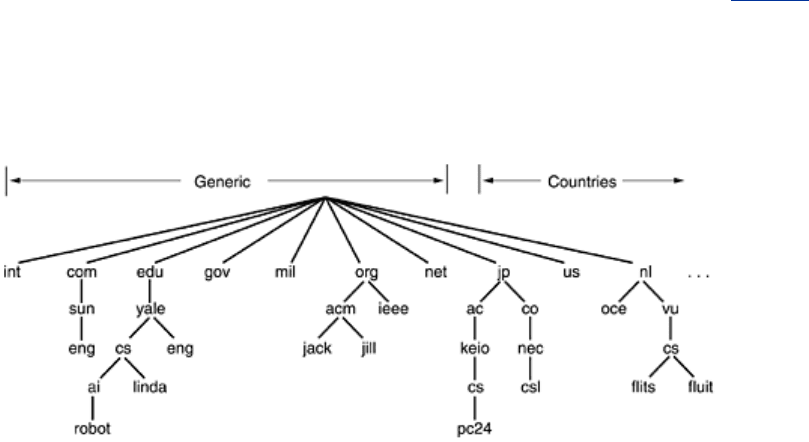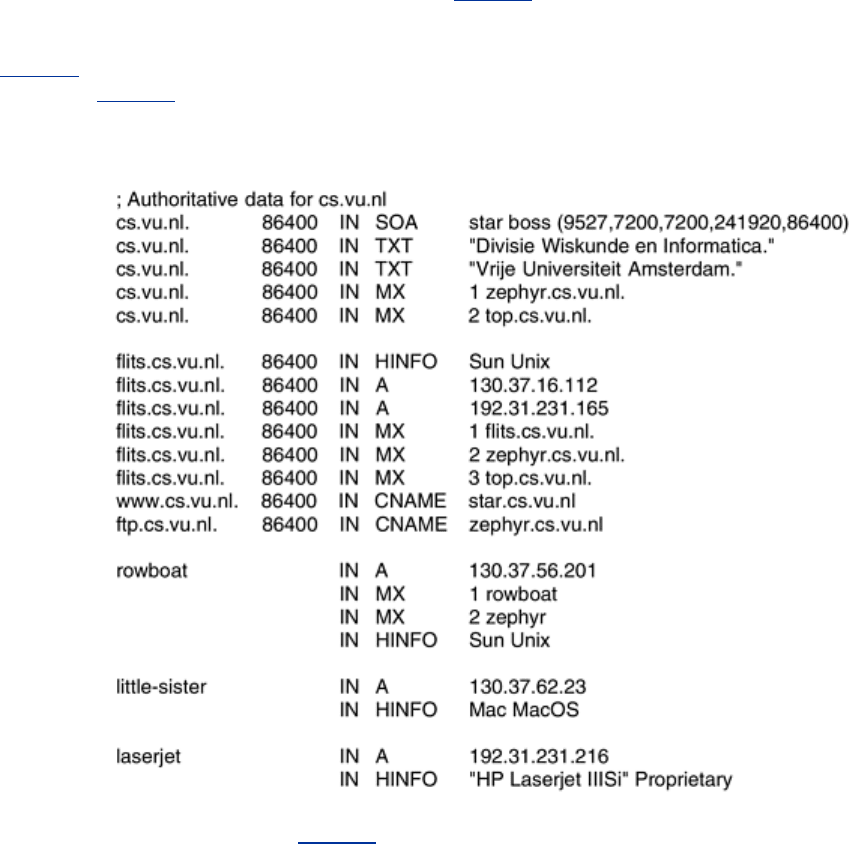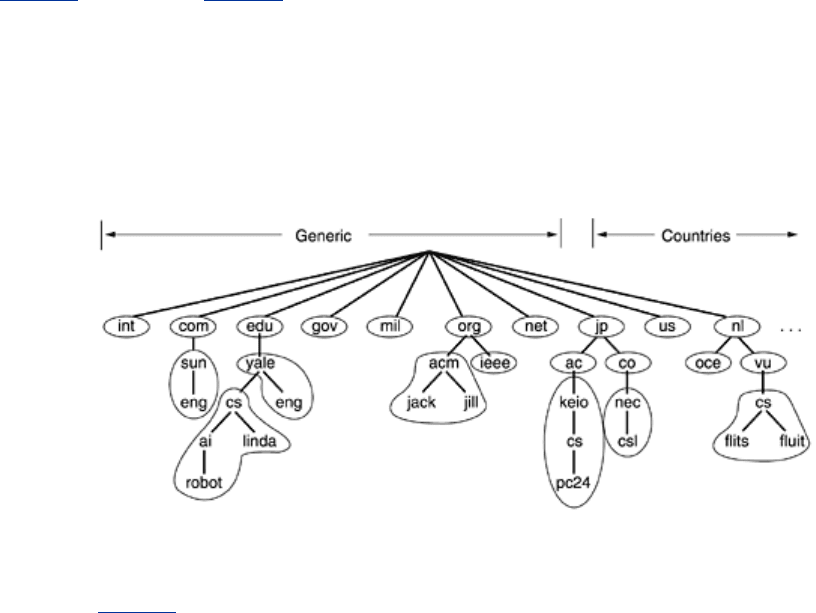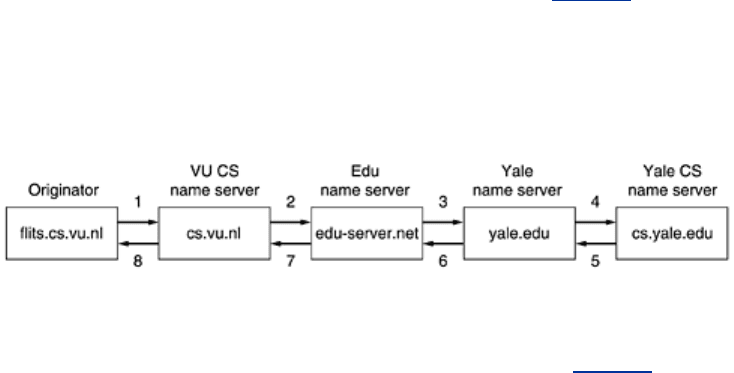Tanenbaum A. Computer Networks
Подождите немного. Документ загружается.


,7). After writing a massive FORTRAN program to analyze the data, our implementer
discovers that the relation Σ
n
i
= MAX_CONN appears to always be true. Are there any
other invariants involving only these seven variables?
11. What happens when the user of the transport entity given in
Fig. 6-20 sends a zero-
length message? Discuss the significance of your answer.
12. For each event that can potentially occur in the transport entity of
Fig. 6-20, tell
whether it is legal when the user is sleeping in
sending state.
13. Discuss the advantages and disadvantages of credits versus sliding window protocols.
14. Why does UDP exist? Would it not have been enough to just let user processes send
raw IP packets?
15. Consider a simple application-level protocol built on top of UDP that allows a client to
retrieve a file from a remote server residing at a well-known address. The client first
sends a request with file name, and the server responds with a sequence of data
packets containing different parts of the requested file. To ensure reliability and
sequenced delivery, client and server use a stop-and-wait protocol. Ignoring the
obvious performance issue, do you see a problem with this protocol? Think carefully
about the possibility of processes crashing.
16. A client sends a 128-byte request to a server located 100 km away over a 1-gigabit
optical fiber. What is the efficiency of the line during the remote procedure call?
17. Consider the situation of the previous problem again. Compute the minimum possible
response time both for the given 1-Gbps line and for a 1-Mbps line. What conclusion
can you draw?
18. Both UDP and TCP use port numbers to identify the destination entity when delivering a
message. Give two reasons for why these protocols invented a new abstract ID (port
numbers), instead of using process IDs, which already existed when these protocols
were designed.
19. What is the total size of the minimum TCP MTU, including TCP and IP overhead but not
including data link layer overhead?
20. Datagram fragmentation and reassembly are handled by IP and are invisible to TCP.
Does this mean that TCP does not have to worry about data arriving in the wrong
order?
21. RTP is used to transmit CD-quality audio, which makes a pair of 16-bit samples 44,100
times/sec, one sample for each of the stereo channels. How many packets per second
must RTP transmit?
22. Would it be possible to place the RTP code in the operating system kernel, along with
the UDP code? Explain your answer.
23. A process on host 1 has been assigned port
p, and a process on host 2 has been
assigned port
q. Is it possible for there to be two or more TCP connections between
these two ports at the same time?
24. In
Fig. 6-29 we saw that in addition to the 32-bit Acknowledgement field, there is an
ACK bit in the fourth word. Does this really add anything? Why or why not?
25. The maximum payload of a TCP segment is 65,495 bytes. Why was such a strange
number chosen?
26. Describe two ways to get into the
SYN RCVD state of Fig. 6-33.
27. Give a potential disadvantage when Nagle's algorithm is used on a badly-congested
network.
28. Consider the effect of using slow start on a line with a 10-msec round-trip time and no
congestion. The receive window is 24 KB and the maximum segment size is 2 KB. How
long does it take before the first full window can be sent?
29. Suppose that the TCP congestion window is set to 18 KB and a timeout occurs. How big
will the window be if the next four transmission bursts are all successful? Assume that
the maximum segment size is 1 KB.
30. If the TCP round-trip time,
RTT, is currently 30 msec and the following
acknowledgements come in after 26, 32, and 24 msec, respectively, what is the new
RTT estimate using the Jacobson algorithm? Use α = 0.9.
31. A TCP machine is sending full windows of 65,535 bytes over a 1-Gbps channel that has
a 10-msec one-way delay. What is the maximum throughput achievable? What is the
line efficiency?
441

32. What is the fastest line speed at which a host can blast out 1500-byte TCP payloads
with a 120-sec maximum packet lifetime without having the sequence numbers wrap
around? Take TCP, IP, and Ethernet overhead into consideration. Assume that Ethernet
frames may be sent continuously.
33. In a network that has a maximum TPDU size of 128 bytes, a maximum TPDU lifetime of
30 sec, and an 8-bit sequence number, what is the maximum data rate per connection?
34. Suppose that you are measuring the time to receive a TPDU. When an interrupt occurs,
you read out the system clock in milliseconds. When the TPDU is fully processed, you
read out the clock again. You measure 0 msec 270,000 times and 1 msec 730,000
times. How long does it take to receive a TPDU?
35. A CPU executes instructions at the rate of 1000 MIPS. Data can be copied 64 bits at a
time, with each word copied costing 10 instructions. If an coming packet has to be
copied four times, can this system handle a 1-Gbps line? For simplicity, assume that all
instructions, even those instructions that read or write memory, run at the full 1000-
MIPS rate.
36. To get around the problem of sequence numbers wrapping around while old packets still
exist, one could use 64-bit sequence numbers. However, theoretically, an optical fiber
can run at 75 Tbps. What maximum packet lifetime is required to make sure that future
75 Tbps networks do not have wraparound problems even with 64-bit sequence
numbers? Assume that each byte has its own sequence number, as TCP does.
37. Give one advantage of RPC on UDP over transactional TCP. Give one advantage of
T/TCP over RPC.
38. In
Fig. 6-40(a), we see that it takes 9 packets to complete the RPC. Are there any
circumstances in which it takes exactly 10 packets?
39. In
Sec. 6.6.5, we calculated that a gigabit line dumps 80,000 packets/sec on the host,
giving it only 6250 instructions to process it and leaving half the CPU time for
applications. This calculation assumed a 1500-byte packet. Redo the calculation for an
ARPANET-sized packet (128 bytes). In both cases, assume that the packet sizes given
include all overhead.
40. For a 1-Gbps network operating over 4000 km, the delay is the limiting factor, not the
bandwidth. Consider a MAN with the average source and destination 20 km apart. At
what data rate does the round-trip delay due to the speed of light equal the
transmission delay for a 1-KB packet?
41. Calculate the bandwidth-delay product for the following networks: (1) T1 (1.5 Mbps),
(2) Ethernet (10 Mbps), (3) T3 (45 Mbps), and (4) STS-3 (155 Mbps). Assume an RTT
of 100 msec. Recall that a TCP header has 16 bits reserved for Window Size. What are
its implications in light of your calculations?
42. What is the bandwidth-delay product for a 50-Mbps channel on a geostationary
satellite? If the packets are all 1500 bytes (including overhead), how big should the
window be in packets?
43. The file server of
Fig. 6-6 is far from perfect and could use a few improvements. Make
the following modifications.
a. (a) Give the client a third argument that specifies a byte range.
b. (b) Add a client flag
–w that allows the file to be written to the server.
1. Modify the program of
Fig. 6-20 to do error recovery. Add a new packet type, reset,
that can arrive after a connection has been opened by both sides but closed by neither.
This event, which happens simultaneously on both ends of the connection, means that
any packets that were in transit have either been delivered or destroyed, but in either
case are no longer in the subnet.
2. Write a program that simulates buffer management in a transport entity, using a sliding
window for flow control rather than the credit system of
Fig. 6-20. Let higher-layer
processes randomly open connections, send data, and close connections. To keep it
simple, have all the data travel from machine
A to machine B, and none the other way.
Experiment with different buffer allocation strategies at
B, such as dedicating buffers to
specific connections versus a common buffer pool, and measure the total throughput
achieved by each one.
442
3. Design and implement a chat system that allows multiple groups of users to chat. A
chat coordinator resides at a well-known network address, uses UDP for communication
with chat clients, sets up chat servers for each chat session, and maintains a chat
session directory. There is one chat server per chat session. A chat server uses TCP for
communication with clients. A chat client allows users to start, join, and leave a chat
session. Design and implement the coordinator, server, and client code.
443

Chapter 7. The Application Layer
Having finished all the preliminaries, we now come to the layer where all the applications are
found. The layers below the application layer are there to provide reliable transport, but they
do not do real work for users. In this chapter we will study some real network applications.
However, even in the application layer there is a need for support protocols, to allow the
applications to function. Accordingly, we will look at one of these before starting with the
applications themselves. The item in question is DNS, which handles naming within the
Internet. After that, we will examine three real applications: electronic mail, the World Wide
Web, and finally, multimedia.
7.1 DNS—The Domain Name System
Although programs theoretically could refer to hosts, mailboxes, and other resources by their
network (e.g., IP) addresses, these addresses are hard for people to remember. Also, sending
e-mail to
tana@128.111.24.41 means that if Tana's ISP or organization moves the mail server
to a different machine with a different IP address, her e-mail address has to change.
Consequently, ASCII names were introduced to decouple machine names from machine
addresses. In this way, Tana's address might be something like
tana@art.ucsb.edu.
Nevertheless, the network itself understands only numerical addresses, so some mechanism is
required to convert the ASCII strings to network addresses. In the following sections we will
study how this mapping is accomplished in the Internet.
Way back in the ARPANET, there was simply a file,
hosts.txt, that listed all the hosts and their
IP addresses. Every night, all the hosts would fetch it from the site at which it was maintained.
For a network of a few hundred large timesharing machines, this approach worked reasonably
well.
However, when thousands of minicomputers and PCs were connected to the net, everyone
realized that this approach could not continue to work forever. For one thing, the size of the
file would become too large. However, even more important, host name conflicts would occur
constantly unless names were centrally managed, something unthinkable in a huge
international network due to the load and latency. To solve these problems,
DNS (the Domain
Name System
) was invented.
The essence of DNS is the invention of a hierarchical, domain-based naming scheme and a
distributed database system for implementing this naming scheme. It is primarily used for
mapping host names and e-mail destinations to IP addresses but can also be used for other
purposes. DNS is defined in RFCs 1034 and 1035.
Very briefly, the way DNS is used is as follows. To map a name onto an IP address, an
application program calls a library procedure called the
resolver, passing it the name as a
parameter. We saw an example of a resolver,
gethostbyname, in Fig. 6-6. The resolver sends
a UDP packet to a local DNS server, which then looks up the name and returns the IP address
to the resolver, which then returns it to the caller. Armed with the IP address, the program can
then establish a TCP connection with the destination or send it UDP packets.
7.1.1 The DNS Name Space
Managing a large and constantly changing set of names is a nontrivial problem. In the postal
system, name management is done by requiring letters to specify (implicitly or explicitly) the
country, state or province, city, and street address of the addressee. By using this kind of
hierarchical addressing, there is no confusion between the Marvin Anderson on Main St. in
444

White Plains, N.Y. and the Marvin Anderson on Main St. in Austin, Texas. DNS works the same
way.
Conceptually, the Internet is divided into over 200 top-level
domains, where each domain
covers many hosts. Each domain is partitioned into subdomains, and these are further
partitioned, and so on. All these domains can be represented by a tree, as shown in
Fig. 7-1.
The leaves of the tree represent domains that have no subdomains (but do contain machines,
of course). A leaf domain may contain a single host, or it may represent a company and
contain thousands of hosts.
Figure 7-1. A portion of the Internet domain name space.
The top-level domains come in two flavors: generic and countries. The original generic
domains were
com (commercial), edu (educational institutions), gov (the U.S. Federal
Government),
int (certain international organizations), mil (the U.S. armed forces), net
(network providers), and
org (nonprofit organizations). The country domains include one entry
for every country, as defined in ISO 3166.
In November 2000, ICANN approved four new, general-purpose, top-level domains, namely,
biz (businesses), info (information), name (people's names), and pro (professions, such as
doctors and lawyers). In addition, three more specialized top-level domains were introduced at
the request of certain industries. These are
aero (aerospace industry), coop (co-operatives),
and
museum (museums). Other top-level domains will be added in the future.
As an aside, as the Internet becomes more commercial, it also becomes more contentious.
Take
pro, for example. It was intended for certified professionals. But who is a professional?
And certified by whom? Doctors and lawyers clearly are professionals. But what about
freelance photographers, piano teachers, magicians, plumbers, barbers, exterminators, tattoo
artists, mercenaries, and prostitutes? Are these occupations professional and thus eligible for
pro domains? And if so, who certifies the individual practitioners?
In general, getting a second-level domain, such as
name-of-company.com, is easy. It merely
requires going to a registrar for the corresponding top-level domain (
com in this case) to check
if the desired name is available and not somebody else's trademark. If there are no problems,
the requester pays a small annual fee and gets the name. By now, virtually every common
(English) word has been taken in the
com domain. Try household articles, animals, plants,
body parts, etc. Nearly all are taken.
Each domain is named by the path upward from it to the (unnamed) root. The components are
separated by periods (pronounced ''dot''). Thus, the engineering department at Sun
Microsystems might be
eng.sun.com., rather than a UNIX-style name such as /com/sun/eng.
Notice that this hierarchical naming means that
eng.sun.com. does not conflict with a potential
use of
eng in eng.yale.edu., which might be used by the Yale English department.
445
Domain names can be either absolute or relative. An absolute domain name always ends with
a period (e.g.,
eng.sun.com.), whereas a relative one does not. Relative names have to be
interpreted in some context to uniquely determine their true meaning. In both cases, a named
domain refers to a specific node in the tree and all the nodes under it.
Domain names are case insensitive, so
edu, Edu, and EDU mean the same thing. Component
names can be up to 63 characters long, and full path names must not exceed 255 characters.
In principle, domains can be inserted into the tree in two different ways. For example,
cs.yale.edu could equally well be listed under the us country domain as cs.yale.ct.us. In
practice, however, most organizations in the United States are under a generic domain, and
most outside the United States are under the domain of their country. There is no rule against
registering under two top-level domains, but few organizations except multinationals do it
(e.g.,
sony.com and sony.nl).
Each domain controls how it allocates the domains under it. For example, Japan has domains
ac.jp and co.jp that mirror edu and com. The Netherlands does not make this distinction and
puts all organizations directly under
nl. Thus, all three of the following are university computer
science departments:
1.
cs.yale.edu (Yale University, in the United States)
2.
cs.vu.nl (Vrije Universiteit, in The Netherlands)
3.
cs.keio.ac.jp (Keio University, in Japan)
To create a new domain, permission is required of the domain in which it will be included. For
example, if a VLSI group is started at Yale and wants to be known as
vlsi.cs.yale.edu, it has to
get permission from whoever manages
cs.yale.edu. Similarly, if a new university is chartered,
say, the University of Northern South Dakota, it must ask the manager of the
edu domain to
assign it
unsd.edu. In this way, name conflicts are avoided and each domain can keep track of
all its subdomains. Once a new domain has been created and registered, it can create
subdomains, such as
cs.unsd.edu, without getting permission from anybody higher up the
tree.
Naming follows organizational boundaries, not physical networks. For example, if the computer
science and electrical engineering departments are located in the same building and share the
same LAN, they can nevertheless have distinct domains. Similarly, even if computer science is
split over Babbage Hall and Turing Hall, the hosts in both buildings will normally belong to the
same domain.
7.1.2 Resource Records
Every domain, whether it is a single host or a top-level domain, can have a set of resource
records
associated with it. For a single host, the most common resource record is just its IP
address, but many other kinds of resource records also exist. When a resolver gives a domain
name to DNS, what it gets back are the resource records associated with that name. Thus, the
primary function of DNS is to map domain names onto resource records.
A resource record is a five-tuple. Although they are encoded in binary for efficiency, in most
expositions, resource records are presented as ASCII text, one line per resource record. The
format we will use is as follows:
Domain_name Time_to_live Class Type Value
The
Domain_name tells the domain to which this record applies. Normally, many records exist
for each domain and each copy of the database holds information about multiple domains. This
446

field is thus the primary search key used to satisfy queries. The order of the records in the
database is not significant.
The
Time_to_live field gives an indication of how stable the record is. Information that is highly
stable is assigned a large value, such as 86400 (the number of seconds in 1 day). Information
that is highly volatile is assigned a small value, such as 60 (1 minute). We will come back to
this point later when we have discussed caching.
The third field of every resource record is the
Class. For Internet information, it is always IN.
For non-Internet information, other codes can be used, but in practice, these are rarely seen.
The
Type field tells what kind of record this is. The most important types are listed in Fig. 7-2.
Figure 7-2. . The principal DNS resource record types for IPv4.
An
SOA record provides the name of the primary source of information about the name
server's zone (described below), the e-mail address of its administrator, a unique serial
number, and various flags and timeouts.
The most important record type is the
A (Address) record. It holds a 32-bit IP address for
some host. Every Internet host must have at least one IP address so that other machines can
communicate with it. Some hosts have two or more network connections, in which case they
will have one type
A resource record per network connection (and thus per IP address). DNS
can be configured to cycle through these, returning the first record on the first request, the
second record on the second request, and so on.
The next most important record type is the
MX record. It specifies the name of the host
prepared to accept e-mail for the specified domain. It is used because not every machine is
prepared to accept e-mail. If someone wants to send e-mail to, for example,
bill@microsoft.com, the sending host needs to find a mail server at microsoft.com that is
willing to accept e-mail. The
MX record can provide this information.
The
NS records specify name servers. For example, every DNS database normally has an NS
record for each of the top-level domains, so, for example, e-mail can be sent to distant parts
of the naming tree. We will come back to this point later.
CNAME records allow aliases to be created. For example, a person familiar with Internet
naming in general and wanting to send a message to someone whose login name is
paul in the
computer science department at M.I.T. might guess that
paul@cs.mit.edu will work. Actually,
this address will not work, because the domain for M.I.T.'s computer science department is
lcs.mit.edu. However, as a service to people who do not know this, M.I.T. could create a
CNAME entry to point people and programs in the right direction. An entry like this one might
do the job:
447

cs.mit.edu 86400 IN CNAME lcs.mit.edu
Like
CNAME, PTR points to another name. However, unlike CNAME, which is really just a macro
definition,
PTR is a regular DNS datatype whose interpretation depends on the context in which
it is found. In practice, it is nearly always used to associate a name with an IP address to allow
lookups of the IP address and return the name of the corresponding machine. These are called
reverse lookups.
HINFO records allow people to find out what kind of machine and operating system a domain
corresponds to. Finally,
TXT records allow domains to identify themselves in arbitrary ways.
Both of these record types are for user convenience. Neither is required, so programs cannot
count on getting them (and probably cannot deal with them if they do get them).
Finally, we have the
Value field. This field can be a number, a domain name, or an ASCII
string. The semantics depend on the record type. A short description of the
Value fields for
each of the principal record types is given in
Fig. 7-2.
For an example of the kind of information one might find in the DNS database of a domain, see
Fig. 7-3. This figure depicts part of a (semihypothetical) database for the cs.vu.nl domain
shown in
Fig. 7-1. The database contains seven types of resource records.
Figure 7-3. A portion of a possible DNS database for cs.vu.nl
The first noncomment line of
Fig. 7-3 gives some basic information about the domain, which
will not concern us further. The next two lines give textual information about where the
domain is located. Then come two entries giving the first and second places to try to deliver e-
mail sent to
person@cs.vu.nl. The zephyr (a specific machine) should be tried first. If that
fails, the
top should be tried as the next choice.
After the blank line, added for readability, come lines telling that the
flits is a Sun workstation
running UNIX and giving both of its IP addresses. Then three choices are given for handling e-
448

mail sent to flits.cs.vu.nl. First choice is naturally the flits itself, but if it is down, the zephyr
and
top are the second and third choices. Next comes an alias, www.cs.vu.nl, so that this
address can be used without designating a specific machine. Creating this alias allows
cs.vu.nl
to change its World Wide Web server without invalidating the address people use to get to it. A
similar argument holds for
ftp.cs.vu.nl.
The next four lines contain a typical entry for a workstation, in this case,
rowboat.cs.vu.nl. The
information provided contains the IP address, the primary and secondary mail drops, and
information about the machine. Then comes an entry for a non-UNIX system that is not
capable of receiving mail itself, followed by an entry for a laser printer that is connected to the
Internet.
What are not shown (and are not in this file) are the IP addresses used to look up the top-level
domains. These are needed to look up distant hosts, but since they are not part of the
cs.vu.nl
domain, they are not in this file. They are supplied by the root servers, whose IP addresses are
present in a system configuration file and loaded into the DNS cache when the DNS server is
booted. There are about a dozen root servers spread around the world, and each one knows
the IP addresses of all the top-level domain servers. Thus, if a machine knows the IP address
of at least one root server, it can look up any DNS name.
7.1.3 Name Servers
In theory at least, a single name server could contain the entire DNS database and respond to
all queries about it. In practice, this server would be so overloaded as to be useless.
Furthermore, if it ever went down, the entire Internet would be crippled.
To avoid the problems associated with having only a single source of information, the DNS
name space is divided into nonoverlapping
zones. One possible way to divide the name space
of
Fig. 7-1 is shown in Fig. 7-4. Each zone contains some part of the tree and also contains
name servers holding the information about that zone. Normally, a zone will have one primary
name server, which gets its information from a file on its disk, and one or more secondary
name servers, which get their information from the primary name server. To improve
reliability, some servers for a zone can be located outside the zone.
Figure 7-4. Part of the DNS name space showing the division into
zones.
Where the zone boundaries are placed within a zone is up to that zone's administrator. This
decision is made in large part based on how many name servers are desired, and where. For
example, in
Fig. 7-4, Yale has a server for yale.edu that handles eng.yale.edu but not
cs.yale.edu, which is a separate zone with its own name servers. Such a decision might be
made when a department such as English does not wish to run its own name server, but a
449

department such as computer science does. Consequently, cs.yale.edu is a separate zone but
eng.yale.edu is not.
When a resolver has a query about a domain name, it passes the query to one of the local
name servers. If the domain being sought falls under the jurisdiction of the name server, such
as
ai.cs.yale.edu falling under cs.yale.edu, it returns the authoritative resource records. An
authoritative record is one that comes from the authority that manages the record and is
thus always correct. Authoritative records are in contrast to cached records, which may be out
of date.
If, however, the domain is remote and no information about the requested domain is available
locally, the name server sends a query message to the top-level name server for the domain
requested. To make this process clearer, consider the example of
Fig. 7-5. Here, a resolver on
flits.cs.vu.nl wants to know the IP address of the host linda.cs.yale.edu. In step 1, it sends a
query to the local name server,
cs.vu.nl. This query contains the domain name sought, the
type (
A) and the class (IN).
Figure 7-5. How a resolver looks up a remote name in eight steps.
Let us suppose the local name server has never had a query for this domain before and knows
nothing about it. It may ask a few other nearby name servers, but if none of them know, it
sends a UDP packet to the server for
edu given in its database (see Fig. 7-5), edu-server.net.
It is unlikely that this server knows the address of
linda.cs.yale.edu, and probably does not
know
cs.yale.edu either, but it must know all of its own children, so it forwards the request to
the name server for
yale.edu (step 3). In turn, this one forwards the request to cs.yale.edu
(step 4), which must have the authoritative resource records. Since each request is from a
client to a server, the resource record requested works its way back in steps 5 through 8.
Once these records get back to the
cs.vu.nl name server, they will be entered into a cache
there, in case they are needed later. However, this information is not authoritative, since
changes made at
cs.yale.edu will not be propagated to all the caches in the world that may
know about it. For this reason, cache entries should not live too long. This is the reason that
the
Time_to_live field is included in each resource record. It tells remote name servers how
long to cache records. If a certain machine has had the same IP address for years, it may be
safe to cache that information for 1 day. For more volatile information, it might be safer to
purge the records after a few seconds or a minute.
It is worth mentioning that the query method described here is known as a
recursive query,
since each server that does not have the requested information goes and finds it somewhere,
then reports back. An alternative form is also possible. In this form, when a query cannot be
satisfied locally, the query fails, but the name of the next server along the line to try is
returned. Some servers do not implement recursive queries and always return the name of the
next server to try.
It is also worth pointing out that when a DNS client fails to get a response before its timer
goes off, it normally will try another server next time. The assumption here is that the server
is probably down, rather than that the request or reply got lost.
While DNS is extremely important to the correct functioning of the Internet, all it really does is
map symbolic names for machines onto their IP addresses. It does not help locate people,
resources, services, or objects in general. For locating these things, another directory service
450
